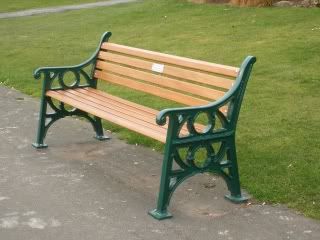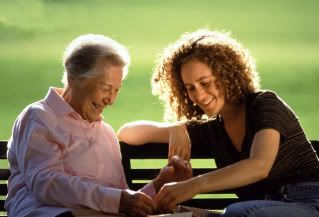The Benches
No matter if it's the world stage or a small residential community, behind most perceived impressions of a given event or situation there's always something else  transpiring. Yet, we never know how an overt action by some individuals might change events, altering the outcome for the greater good.
transpiring. Yet, we never know how an overt action by some individuals might change events, altering the outcome for the greater good.
 transpiring. Yet, we never know how an overt action by some individuals might change events, altering the outcome for the greater good.
transpiring. Yet, we never know how an overt action by some individuals might change events, altering the outcome for the greater good. In this situation, behind the idyllic image presented to the outside world of a harmonic residential area, disharmony was lurking.Four miles of park-like walkways grace the over-55 community. Residents are out on the trails every day walking their dogs, exercising, or bike riding past the manicured gardens and lawns. Occasionally, an elderly spouse can be seen pushing the wheelchair of a sick partner. What sets the community apart is consistent friendliness. Neighbors will always say hello as they pass one another on the sidewalks or wave as they drive by. However, noticing the advanced age of some residents, a recommendation was made to the Board that benches be installed along the walkways so older, tired, or ill walkers could rest.
It seemed like an easy solution to install a few benches. But that was not the case. After the proposal was made, unpleasant debates and nasty comments raged  for months about the wisdom or necessity of the benches. While most wanted the benches, a vocal group expressed major objections. Finally, after a vote by a quorum of residents, the Board, in an attempt to please everyone, made a decision to install "two trial benches."
for months about the wisdom or necessity of the benches. While most wanted the benches, a vocal group expressed major objections. Finally, after a vote by a quorum of residents, the Board, in an attempt to please everyone, made a decision to install "two trial benches."
 for months about the wisdom or necessity of the benches. While most wanted the benches, a vocal group expressed major objections. Finally, after a vote by a quorum of residents, the Board, in an attempt to please everyone, made a decision to install "two trial benches."
for months about the wisdom or necessity of the benches. While most wanted the benches, a vocal group expressed major objections. Finally, after a vote by a quorum of residents, the Board, in an attempt to please everyone, made a decision to install "two trial benches." The benches were placed in a tranquil area near two large lakes next to a main walkway. Within days of placing the benches by the lakes, residents were shocked when they discovered one of them had been spray painted with black paint. The word "NO!" was scrawled across the slats. The shocking part was that this was not the act of outsiders. The community is walled, gated and has 24 hour security guards. It was done by someone inside the gates. Discussion followed and the offending paint was removed. But the bench remained. But soon after the first incident, the second bench was found tossed into the lake. Concerned with the bad manners, the Board sent a notice saying that new benches would be permanently installed in concrete, regardless of the adolescent behavior on the part of a few. The vandalism stopped.
Since the permanent benches were installed, a different tone prevailed in the  community. Attitudes shifted once the concrete was set. Whatever reservations or objections people previously had about the benches were gone. The sounds of laughter and chatter could be heard throughout the day, as different residents appeared at the benches at different times of the day. The benches became gathering places where people exchanged stories about their dogs, their days, or their lives. If someone was ill, the word quickly went out. If there was a birthday, good wishes were relayed. Even the dogs seemed to enjoy the space, cavorting with their own new fur-friends.
community. Attitudes shifted once the concrete was set. Whatever reservations or objections people previously had about the benches were gone. The sounds of laughter and chatter could be heard throughout the day, as different residents appeared at the benches at different times of the day. The benches became gathering places where people exchanged stories about their dogs, their days, or their lives. If someone was ill, the word quickly went out. If there was a birthday, good wishes were relayed. Even the dogs seemed to enjoy the space, cavorting with their own new fur-friends.
 community. Attitudes shifted once the concrete was set. Whatever reservations or objections people previously had about the benches were gone. The sounds of laughter and chatter could be heard throughout the day, as different residents appeared at the benches at different times of the day. The benches became gathering places where people exchanged stories about their dogs, their days, or their lives. If someone was ill, the word quickly went out. If there was a birthday, good wishes were relayed. Even the dogs seemed to enjoy the space, cavorting with their own new fur-friends.
community. Attitudes shifted once the concrete was set. Whatever reservations or objections people previously had about the benches were gone. The sounds of laughter and chatter could be heard throughout the day, as different residents appeared at the benches at different times of the day. The benches became gathering places where people exchanged stories about their dogs, their days, or their lives. If someone was ill, the word quickly went out. If there was a birthday, good wishes were relayed. Even the dogs seemed to enjoy the space, cavorting with their own new fur-friends. Just as the Benches became a focal point for the fears and intolerance of some individuals in a small community, so a proposed community-center located two blocks from the scene of great devastation and horror has become the rallying point of intolerance and fear among another group of people. Heated discussions about immigration or building mosques continue to agitate citizens and governments. Xenophobia has become one of the barometers in how we treat one another. Yet, most religious and spiritual leaders call for mutual respect and tolerance in the name of their religions.
Fear seems to be the driving force behind many ill-mannered discussions. Fear of the unknown. Fear of change. Fear of someone who is not of the same culture or upbringing. Fear  that there won't be enough. Or fear that someone will get something they're not entitled to. In this abundant universe there's always more than enough for everyone. But most don't believe that.
that there won't be enough. Or fear that someone will get something they're not entitled to. In this abundant universe there's always more than enough for everyone. But most don't believe that.
 that there won't be enough. Or fear that someone will get something they're not entitled to. In this abundant universe there's always more than enough for everyone. But most don't believe that.
that there won't be enough. Or fear that someone will get something they're not entitled to. In this abundant universe there's always more than enough for everyone. But most don't believe that. What do we believe? How do we stack up when faced with something unfamiliar, or when faced with our fears? Do we judge every hateful act by a person's religion, culture or country? The residential community didn't characterize the acts of vandalism on the benches by religion or culture. They merely called it childish and boorish. But they persevered in serving the common good.
The message of the gentle, mystic teacher Inayat Khan was unity. He felt if all of humanity could be brought together we would rise above the differences and distinctions that separate us. In working towards the unity of all religions, he envisioned a prayer service that honored all the religious traditions of the world as equal sources of spirituality. The service became known as Universal Worship.
Cooler heads brought discordant factions in a small residential community together when The Benches became gathering places of laughter and easy conversation. Is it possible that a different dialogue regarding Ground Zero might take place that brings people together rather than pulls them apart? What if, instead of condemning a community center that is not even visible to Ground Zero, open-minded people  embraced the idea of Unity suggested by Inayat Khan?
embraced the idea of Unity suggested by Inayat Khan?
 embraced the idea of Unity suggested by Inayat Khan?
embraced the idea of Unity suggested by Inayat Khan? Could you imagine a garden-like setting where 8 stone plaques and 8 stone benches are placed in a circle at Ground Zero? Each stone and bench would be inscribed with the symbol and the name of one of the 8 major religions of the world. Perhaps future visitors to Ground Zero might sit in the circle of benches and see the unity of all religions and all people instead of the horrors of disharmony that caused the destruction. Maybe the benches might become gathering places where people from all cultures come to exchange good wishes. Maybe the charter of the United Nations which includes "respect, universal peace, and the harmonizing action of nations" might be recorded in that garden. Maybe it's worth considering some benches.
Jo - September 2010
